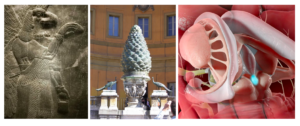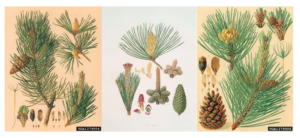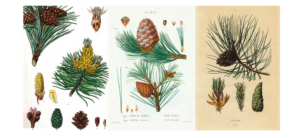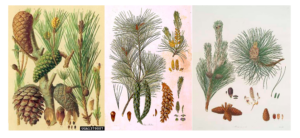Seasonally speaking, it’s this time of year that the prevalence of coughs, colds and flu appears to increase and the iconic pine tree begins to come into its own. The relationship between the pine tree and this time of year has relevance indeed – but there’s a bit of misunderstanding about the pine tree and its connection to Christmas. In celebration of all things trees and forest, I feel compelled to share a little about the world of pine, its essential oil benefits and folklore…
Most people assume that the pine tree is traditionally used as a Christmas tree but in fact it is not the pine species that is grown commercially for this purpose, instead it is usually either a fir or spruce tree variety. Commonly Christmas trees are either Siberian firs or Norway spruce trees varieties such as Douglas firs and the traditional Nordman fir with its iconic blue needles that most people go out and lovingly select for their homes at this time of year. A native of Scandinavia the Norway spruce is completely frost Hardy with thick bark to protect it and thin waxy needles and it is the typical tree that was gifted by the Norwegians to Trafalgar Square for their iconic display each years which has been a tradition since 1947 as an act of gratitude for the support during the Second World War.
Whereas the UK native Scots pine, with its red scaly bark and brown pinecones found in the Scottish Highlands is actually the least common tree grown commercially for Christmas. Instead, the pine is more likely busy providing homes for rare species such as red squirrels and pine Martens as well as supplying us with a wealth of beautiful essential oil.
Aside from these roles, the pine tree does have a mysterious a symbolic tradition across global history. Interestingly the pineal gland or the ‘third eye’, said to be the centre of human ‘inner vision’ or ‘second sight’, is in fact the actual shape of a small pinecone giving a large clue as to where its name originated. Therefore, in some ancient cultures it has represented symbolically this ‘eye of God’ and is depicted in Egyptian, Assyrian and Sumerian artworks and hieroglyphics where images of gods and priests either hold a cone or carry a staff with a pinecone on the end. In the Vatican there is a huge sculpture of a pinecone said to be as old as Roman times which has been this become the centrepiece of one of the courtyards and the Pope himself carries a staff with the said pine cone on the end of it indicating that the pineal gland and cone on the tree are both sacred symbols of power insight and vision.

Aromatically speaking, if you have ever chopped or sawn Pinewood for open fires or wood burners or you may notice the thick sweet clear resin coming from freshly cut wood which smells heavenly clean and fresh and it is this resin that helps fires burn so brightly. Pine scent is synonymous with cleansing and many disinfectants for floors are fragranced with pine or contain pine and there is a good reason for this as the essential oils of the pine species are full of antibacterial and antimicrobial compounds. Derived from the twigs and needles of these Evergreen, coniferous trees that originate from temperate boreal forests, the essential oils are dominated by mono terpenes which includes the powerful significant compounds alpha pinene and beta pinene to name but a few.
Fundamentally the breath of fresh air provided by pine essential oil is a respiratory restorative and stimulant, supplying but not just respiratory cleansing and protection in the season of bugs coughs, colds and sore throats but it can also serve to support physical tiredness, chronic burnout exhaustion, low stamina and vitality as with the breath comes energy and strength. Pine can tackle chronic coughs, chest congestion and improve shallow breathing – acting as an expectorant, soothing sore throats, swollen glands, aching muscles and nerves in the respiratory tract. It is suggested that it’s decongestant action can be used to combat and soothe bronchitis, sinusitis laryngitis, pharyngitis and all congested chronic congestive conditions of the upper and lower respiratory tract.
Pine oil can be useful also during heavy menstrual cycles and from a mental health perspective it has been indicated as being useful in depression, and disassociation.
But not only that, pine oil can relieve pelvic congestion and act as a lymphatic decongestant for swollen glands and oedema as well as helping with other conditions such as arthritis rheumatism, gout, gallstones and urinary infections. It has anti-inflammatory and analgesic neuromuscular properties and can even help contribute help combat any smelly excessive foot perspiration bringing freshness to any smelly feet! Working specifically on the pituitary and adrenal axis as a restorative and regulator, it can improve loss of stamina, and any metal metabolic and other neurodegenerative disorders.
On an emotional level, it is suggested that pine oil will improve emotional burnout, promoting motivation. Overall, this uplifting and comforting oil is synonymous with winter freshness and cleansing and even if it can’t be the Christmas tree you thought it would be – this affordable oil is easy to use in the diffuser and will be evocative of Scandinavian forests and winter cheer. It blends well with other Alpine and forest type oils such as black spruce, rosemary cypress, juniper berry, sage and lemon eucalyptus. Used in the diffuser or as a few drops on a tissue placed near a radiator or as a few drops in the bath to uplift and strengthen the immune system, pine will uplift and get you in the mood for a sparkling fresh healthy winter season.
Pine trees and their essential oils come in many varieties – referring to one publication by Peter Holmes Lac, MH, “Aromatica’ – A Clinical Guide to Essential Oil Therapeutics, (Vol 2), there are 11 pine species and oils with aromatic descriptions as:
Scots Pine – Pinus sylvestris
https://www.nhrorganicoils.com/products.php?id=11702
Maritime, Coastal or Sea Pine – Pinus pinaster
https://oshadhi.co.uk/sea-pine-essential-oil/
Austrian, Black Pine – Pinus nigra
https://oshadhi.co.uk/black-pine-organic-essential-oil/
Mugo Pine – Pinus mugo
https://www.nhrorganicoils.com/products.php?id=13031
Swiss Stone Pine – Pinus cembra
https://www.nhrorganicoils.com/products.php?id=13807
Corsican Pine – Pinus nigra subsp.lasricio Poir.
https://oshadhi.co.uk/laricio-pine-organic-essential-oil/
Aleppo Pine – Pinus halpensis Miller
https://hermitageoils.com/product/aleppo-pine-essential-oil/
White Pine – Pinus strobus
https://oshadhi.co.uk/white-pine-organic-essential-oil/
Norway Pine – Pinus resinosa
https://oshadhi.co.uk/norway-pine-essential-oil/
Jack Pine – Pinus banksiana
Ponderosa Pine – Pinus ponderosa




